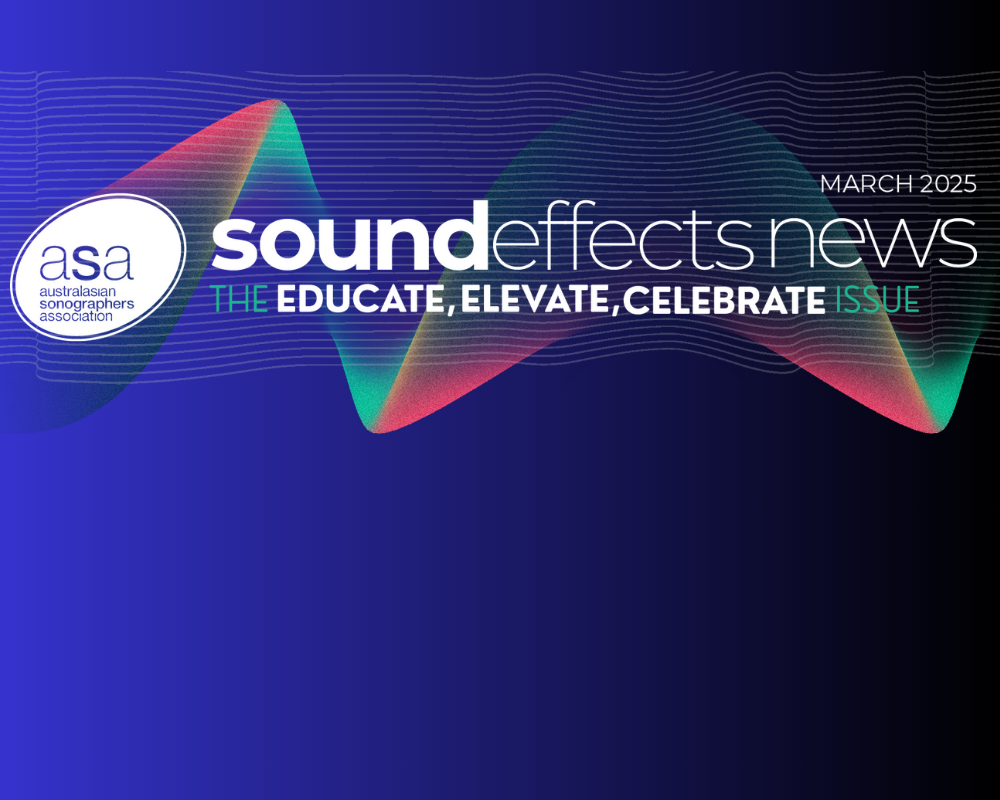
5 minute read
Soundeffects news | Interview with Jerome Boyle
Jerome Boyle | MUSCULOSKELETAL | AUS
Chief Sonographer | Imaging Associates
Jerome Boyle is the Chief Sonographer for the Imaging Associates Group, leading a team of over 50 sonographers. Since beginning his career in 2011, he has developed a strong focus on quality-driven ultrasound that improves patient outcomes. While passionate about all aspects of ultrasound, he has a particular interest in obstetric and musculoskeletal (MSK) imaging.
Jerome has presented at local, state, and national conferences on a range of topics and recently conducted a three-day MSK ultrasound roadshow in Singapore for Philips. He has also contributed to international publications as an author and co-author of several peer-reviewed articles.
At ASA2025 Melbourne, Jerome will share his insights into the latest trends in MSK ultrasound, practical strategies for improving diagnostic accuracy, and the evolving role of technology in the field. In this interview, he discusses key advancements, common challenges, and what the future may hold for MSK sonographers.
You work at the forefront of MSK ultrasound. What key trends are shaping the future of the field?
With the advent of ultra-high-frequency transducers, sonographers can now explore anatomical structures with unprecedented detail using modern ultrasound systems. From submillimetre terminal nerves to subtle tears that are not visible on MRI, our spatial resolution has never been better. Moreover, innovative Doppler technologies have significantly elevated the sensitivity of ultrasound in detecting slow or weak blood flow in musculoskeletal disorders, allowing us to depict conditions earlier, such as rheumatoid.
And so, sonographers have become empowered by this harmonious balance between the most advanced technology the field has ever seen and the cumulative wealth of knowledge and research gleaned across decades of musculoskeletal imaging. It is an exhilarating time to be an MSK sonographer!
How can sonographers elevate their MSK scanning techniques to improve diagnostic accuracy?
In the words of Sir William Osler, ‘Listen to the patient, they are telling you the diagnosis’. Many referring clinicians are time-poor, and evidence would suggest that they often don’t have the full clinical picture before referring patients for imaging. It is imperative that sonographers spend several minutes at the beginning of any MSK examination assessing and prompting patients for clinically relevant information. Scanning without this clinical insight is like going to sea without a nautical chart. Be sure to adopt a clinician’s mindset and use the ultrasound instruments soundly and judiciously to extract the diagnosis from the patient.
Apt MSK scanning isn’t about just taking pictures or following rigid protocols. It’s about using your clinical acumen to make a diagnosis and then using the ultrasound system to confirm this diagnosis. It’s about sonographers who don’t operate like robots using another machine but, instead, approach each case in a tailored and considered manner and take personal ownership of their diagnostic work. It’s about sonographers who strive for excellence and go beyond the bare minimum.
In your experience, what are the most common pitfalls or challenges in MSK ultrasound?
We ‘pre-tension’ ligaments and tendons by isometrically loading them to pull collagen fibres taut to obtain exquisite B-mode images. However, this is a common pitfall in colour Doppler assessment as the tension often compresses neovessels in abnormal structures and reduces Doppler sensitivity. We must, therefore, assess tendon and ligament vascularity with the structure in a relaxed state.
Many sonographers use ‘sonopalpation’ whereby the transducer face is used to push on abnormal structures to elicit a pain response. I have grievances with this as you’re transmitting force over the 5–6 cm area that the transducer covers, and most musculoskeletal structures are far smaller than this (particularly sensory nerves!). The workaround for this is simple. Isolate the abnormal structure using the transducer and centre over it, place the index finger of your non-scanning hand concentrically beneath the transducer face, remove the transducer, and then push with your finger. This will give you a more targeted, controlled and accurate pain response over a much smaller area.
Sonographers are encouraged to push the envelope and extend the scope of any MSK examination. In doing so, we encounter many findings that are not normal but may be of negligible or no clinical significance. Sonographers must use their clinical judgment to filter these in the context of a patient’s presenting symptoms. Downplay findings of doubtful clinical significance and always ensure that you practise clinically relevant MSK ultrasound. Failure to provide the significance between sonographic findings and presenting clinical symptoms may lead to poor patient outcomes.
What do you think is the next big area of growth or innovation in MSK ultrasound?
Extending the scope of practice for sonographers within Australia and New Zealand to allow sonographer-administered ultrasound guided MSK injections. In a utopian world, there would be uniformity and standardisation in regulations to allow this across all states and territories.
Building on the foundation of structured reporting software and sonographer-generated reports, the next reporting innovation is interactive multimedia reporting. That is, digital reports that move away from traditional text-based reporting and offer the ability to embed media such as key images, hyperlinks or even voice messages for referring clinicians. The value added by these media-rich reports for MSK ultrasound and other facets of ultrasound is immense.
The buzzword in radiology is unequivocally ‘AI’ and it would be remiss of me not to acknowledge this. While none of us know what the AI landscape will look like for ultrasound in another decade or two, I think key technological innovations will involve augmenting and assisting sonographer workflow rather than replacing the human element. Watch this space!
Explore Jerome Boyle’s ASA2025 Program
SESSION | PRESENTATION
FRI 12:30 – 2:20pm | Crunch time diagnoses: pathology of the abdominal and chest wall
SAT 11:00am – 12:30pm | Hip ultrasound – time to think zebras
SAT 1:45 – 2:45pm | Workshop: Groin hernias
SUN 11:30am – 12:50pm | Finger ultrasound – a gamut of acute pathologies









